
Twitter shares insights on three things to consider when vetting social listening tools
What’s happening in the world? What are people talking about? How do they feel about certain topics, brands or products? Organizations have tried for a long time to uncover these types of insights through traditional research methods like surveys, focus groups, and interviews.
What if you could take your research to the next level and uncover even deeper insights in real-time? Today, an unprecedented number of people - including your customers, prospects, competitors and other stakeholders - are freely sharing their experiences, interests, and opinions publicly, in real-time, on Twitter.
Twitter is the largest, publicly available, searchable archive of human-generated thought ever. It’s the world’s largest focus group. Are you ready to start listening?
Social Listening: start with why (and what)
Tapping into the world’s largest focus group might seem daunting. The good news is that social listening platforms have the expertise, technology, and tools to make it easier to get started. But, before choosing a vendor, you’ll need to get clear on your objectives.
Are you seeking brand or industry insights? Customer feedback? Crisis monitoring? Something else? And, once you have the data, what type of analysis do you need to perform? Do you want to know how your audience is feeling about a product, service, experience or issue? What about searching images for your brand or your competitor’s logos?
Knowing what you want will form the foundation for finding a social listening tool that best meets your needs.
When you’re ready to start evaluating vendors, keep the following three factors in mind:
1. Data
Access to the relevant data can be a key differentiator among social listening platforms. It’s critical that you understand how they are procuring their social data and from which sources. Areas to probe:
Data Sources: From social channels to blogs, reviews, forums, print & TV, there are many sources of data. Which data sources does the vendor support and, of those, which ones will help you achieve your listening goals? Be ready with your own list of sources, geographic focus, and topics you want to analyze.
Data Providers: Is the platform accessing data via third party brokers, direct from the social networks themselves or by ’scraping’ the web? If they are accessing the data directly from the source, inquire if it’s via publicly available APIs, elevated access or a paid licensing agreement. This is important as changes to APIs and/or commercial agreements could impact your data access. Another important and related question is whether the data provided is being sampled or is full fidelity. Is metadata included?
Historical Data: Looking for insights from the past? If yes, make sure your vendor has that capability. Does the social listening tool provide access to historical data from its various sources? If so, how far back in time, and is this full fidelity or sampled? How long does it take the vendor to access and showcase insights from historical data?
2. Text analysis (Natural Language Processing)
At the heart of any social listening tool is text analysis: the techniques used to understand, organize, and apply sentiment and emotion to text. Some things to consider:
How is the platform performing text analysis? This is really about a vendor’s accuracy when it comes to annotating your data. Social listening tools have a variety of approaches to this, so spend some time discussing how their approach differs from others. You likely will hear acronyms like NLP, ML and AI - make sure your vendor can break these down in an understandable way.
What level of detail is the text analyzed: paragraph, sentence or phrase? At what level is sentiment and emotion applied? Does the vendor guarantee a minimum accuracy, and if so, how is it measured? How is the sentiment scored, and can you override it?
What languages are supported? Can they deliver the same accuracy for each language?
3. Customer experience
When it comes to social listening platforms, your experience matters. To choose a vendor who can act as a true partner, helping you to improve your social listening maturity, consider:
Industry Expertise: Specific industries tend to have their own needs when it comes to social listening. Does the vendor understand and have experience in your industry? Ask for case studies and customer references.
Onboarding & Customer Support: How will they support you to get up and running? Do they provide services to help you build advanced queries and/or validate findings? What SLAs do they offer for customer support?
Alerting, Reporting & Visualizations: Does the social listening tool offer real-time alerts? Do they allow you to create customized alerts and thresholds? When it comes to reporting, does the vendor allow you to easily export charts and graphs? And do they provide display technology for offices and war rooms or command centres?
User Experience: Can the user interface be navigated by a casual user allowing them to build queries and analyze results? Is a query builder available for those who can’t use boolean logic?
When it comes to social listening, you have choices. Get clear on your needs and then carefully evaluate each of the vendors.
This article was originally published on the Twitter Blog. You can get more support from Twitter from their social listening case studies, or you can get in touch with one of their team.
This interview was recorded via LinkedIn Live, if you prefer to view on LinkedIn, click the button below.
View InterviewSee related content

.png)








%20(1).jpeg)

